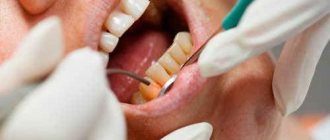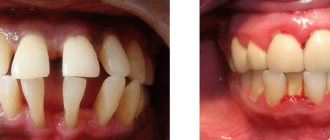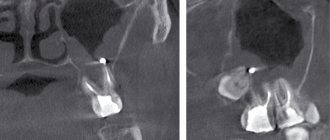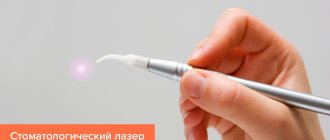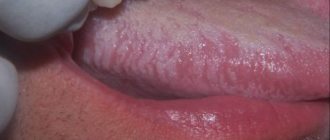From this article you will learn:
- symptoms of lymphadenitis in children and adults,
- reasons for the development of inflammation,
- acute and chronic lymphadenitis - treatment, antibiotics.
The article was written by a doctor with experience in maxillofacial surgery.
Lymphadenitis is an inflammation of one or more lymph nodes that occurs against the background of acute or chronic infection. Most often, lymphadenitis occurs in children (due to the imperfection of their immune system), and at an outpatient appointment with a pediatric dentist, lymphadenitis is diagnosed in approximately 5-7% of all children. Moreover, lymphadenitis in children under 5 years of age occurs primarily due to acute respiratory viral infections, infectious processes in the tonsils, inner and middle ear, and in children after 6-7 years of age - due to foci of purulent inflammation at the roots of the teeth.
In approximately 40% of cases, inflammation of the lymph nodes is not diagnosed in time. This is due to the fact that pediatricians and pediatric dentists, to whom parents most often bring their children for examinations, do not have much experience in working with this pathology. As for adults, lymphadenitis occurs in them much less frequently than in children, and its development is usually caused by a combination of factors - the presence of acute or chronic purulent inflammation + a weakened immune system.
Lymphadenitis: photo
There are many groups of lymph nodes on the face and neck, the main ones being the buccal, parotid, submandibular (submandibular), retromandibular, submental, retropharyngeal, as well as superficial and deep cervical lymph nodes. In healthy children and adults, the lymph nodes are never enlarged, but if they are enlarged, this almost always happens as a result of invasion of pathogenic microorganisms. But we must remember that in some cases, enlarged lymph nodes may indicate tumor growth or blood diseases.
Structure and function of lymph nodes –
In the body, lymph nodes play the role of a biological filter. Lymph nodes retain and destroy pathogenic bacteria and toxins that enter them through lymphatic vessels - from teeth and bones affected by inflammation, tonsils, soft tissues of the face, and other organs and tissues. However, with the constant chronic sedimentation of microorganisms in them, they lose the ability to neutralize them, and in some cases they themselves turn into sources of purulent infection.
Each lymph node has a connective tissue capsule on the outside, from which lymphatic vessels depart, providing inflow or outflow of lymph. Thin connective tissue septa (trabeculae) extend from the capsule into the lymph node, between which the parenchyma is located. Closer to the capsule, the parenchyma consists of lymphoid follicles, and closer to the center of the lymph node - of strands of lymphocytes. The lymph passing through the lymph node is cleared of infectious agents and other antigens, and the so-called “immune memory” is also formed here.
About lymph
The lymphatic system consists of lymph nodes and the vessels that feed them. It is multifunctional, but its main function is to protect the body from various pathogens.
For this purpose, immune cells exist in the lymph nodes - T-lymphocytes and B-lymphocytes.
The passage of blood through small capillaries creates a plasma filtration effect. Some of the blood enters the surrounding tissues, and some goes back into the bloodstream. Another one - into the vessels. The result is the formation of lymph. It is a clear, watery liquid containing immune cells.
Lymphatic vessels, uniting, enter the thoracic lymphatic ducts, right and left, the same, in turn, flow into the veins. This results in the return of fluid to the bloodstream.
Lymph nodes, as part of the body's immune system, are located in different parts of the body. Their task is to be filters, a kind of barriers for infectious carriers and pathogenic cells.
Nodule on the neck or why you need to know the cause of lymphadenitis
A nodule on the neck or why you need to know the cause of lymphadenitis.
Many of us take swollen lymph nodes rather lightly, believing that this trouble will go away on its own. There is, of course, a successful outcome, and the lymph glands are restored to their normal size on their own. But most often, the enlarged nodes begin to hurt, the skin over them turns red, and the temperature in this part of the body rises. This is how lymphadenitis develops - inflammation of the lymph nodes.
We asked general practitioner Dmitry Nikolaevich ZABASHT to tell us more about this disease.
— What is the lymphatic system and what is its role in the body?
— The lymphatic system consists of a network of small vessels that collect excess fluid (lymph), foreign particles and other unnecessary substances from body tissues and cells. This is a kind of drainage system (washing and cleaning). Small lymphatic vessels, merging with each other and flowing into larger ones, pass through the lymph nodes. Lymph nodes are unique filters that trap and neutralize microbes and other toxic substances that have entered the body. Next, the lymphatic vessels, connecting into two large ducts, flow into the blood veins.
— Why do the lymph nodes become inflamed?
— If a large number of microbes enter the lymph node, then it ceases to cope with their neutralization and begins to “scream” for help, that is, to become inflamed. This means that there is some kind of infection in the body.
— Where do lymph nodes usually enlarge?
— The lymph node is a barrier that prevents the infection from spreading further throughout the body. The lymphatic system begins to fight microbes already in its vessels, and therefore very often you can see a pink thin path running from the source of infection to the inflamed lymph node. The cause of lymphadenitis can be a crack in the skin, a splinter, a scratch. A slight suppuration causes mild pain, and a person usually doesn't pay attention to it. But then suddenly it begins to hurt in the groin or armpit areas, swelling appears, the lymph nodes enlarge and become painful to the touch. This means that local immunity could not cope with the infection and it spread further. Each lymph node is responsible for its own specific area in the body. And if the source of infection is, for example, on the leg, then the popliteal node first becomes inflamed. When the protection weakens, the microbes move to the inguinal node. Any infectious process can be accompanied by lymphadenitis. Depending on the location of the microbes, different lymph nodes become inflamed. For example, submandibular lymphadenitis is a sign of caries, tonsillitis (inflammation of the tonsils) or gingivitis (inflammation of the gums). If several lymph nodes become inflamed at once, this means that the infection is too advanced. With painless enlargement of a group of lymph nodes, a tumor process cannot be excluded.
— Therefore, with lymphadenitis, it is not the lymph nodes that need to be treated, but the infection should be fought?
- Absolutely right. If the root cause is removed, the lymphadenitis itself will subside, and the nodes will return to their original appearance (with the exception of their suppuration, which requires more serious attention). Sometimes it is enough to disinfect the wound several times a day to get rid of lymphadenitis. Some diseases (for example, sore throat) are accompanied by inflammation of the lymph nodes, which are restored as the disease subsides. Therefore, you should not rush to discharge, even if the temperature has returned to normal and all the symptoms of the disease have passed, but the lymph nodes are still enlarged and painful. This suggests that the recovery process in the body is not yet complete. And if you neglect this signal, complications cannot be avoided.
— What mistakes do patients make when trying to cope with lymphadenitis on their own?
— You cannot self-medicate for lymphadenitis. It is unacceptable to warm up the nodes or apply ointments to them. If the lymph nodes are enlarged and painful, you should immediately consult a doctor - a therapist or surgeon. Depending on the disease, treatment will be prescribed.
— In what cases do lymph nodes have to be removed?
— Lymph nodes are removed during tumor processes, since they accumulate unneutralized malignant cells, which can spread throughout the body and cause secondary tumors (metastases). Enlarged lymph nodes due to tumors are not lymphadenitis, but outwardly they appear the same.
Daria PONOMAREVA.
By the way, cat scratches are not harmless.
Enlarged lymph nodes can occur from a simple cat scratch if the cat has given you an infection. An infected cat is no different from a healthy one. Cats themselves do not get sick, but they infect humans by scratching, biting, and even licking them. A few days after the injury, the victim’s lymph nodes, which are located in the immediate vicinity of the bite, begin to enlarge, the temperature may rise, and a rash often appears. If the state of the immune system is good, then the disease will go away on its own, causing a lot of trouble. To avoid them, it is advisable to take immediate action. Treat the area of scratches and bites with a 2% solution of hydrogen peroxide, and then with iodine or alcohol. You should not self-medicate; it is better to immediately consult an infectious disease doctor. You may have to add antibiotics or hormonal drugs. Positive results can only be achieved by fighting the underlying disease, which is the root cause of enlarged lymph glands. Preventive measures for cat scratch disease are simple: wash the cat using disinfectants (preparations to kill parasites) and try not to let playtime get too bad with a pet to scratches and bites.
Localization of lymph nodes in the neck
Lymph nodes are located throughout the body. Now we are interested in the neck, where there are such groups of lymph nodes:
- Chin;
- Submandibular;
- Preglottic;
- Jugular;
- Parotid;
- BTE;
- Occipital;
- Posterior cervical;
- Supraclavicular.
Bone biopsy
A medical examination involves feeling them. An enlarged lymph node means certain pathological processes occurring in it. This can be an inflammatory, purulent process, the occurrence of infection, as well as oncology.
Diagnosis of the disease
During the initial examination, the doctor tries to identify the location of inflammation of the lymph node and determine in detail the area of pathology. To establish an accurate diagnosis and prescribe effective treatment, it is necessary to conduct a number of examinations and laboratory tests:
- polymerase chain reaction analysis;
- general blood analysis;
- biopsy to differentiate malignant and benign neoplasms;
- Ultrasound of the lymph node.
Culturological research of biological samples that are sown in nutrient media is practiced. Based on the content of formed colonies, the type of infectious agent, the intensity of the inflammatory process, and the resistance of microbes and viruses to pharmacological drugs are determined. Doctors of narrow specializations - otolaryngologists, dentists, endocrinologists, oncologists, infectious disease specialists, hematologists - can be involved in the diagnosis.
Indications
There are many indications for the procedure:
- Node over 1 cm;
- Soreness;
- Inflammatory process for no apparent reason;
- Suspicion of a malignant tumor;
- The lymph node does not change, although treatment has been carried out for a long time;
- Sarcoidosis or lymphogranulomatosis, etc.
This procedure provides an understanding of:
- What is the specificity of the course of the disease;
- What is the level of infection;
- If a patient with cancer has metastases.
Complications of lymphadenitis –
As for complications, lymphadenitis can be complicated by adenophlegmon, and the latter can lead to the development of phlebitis, thrombophlebitis, and sepsis. The causes of complications are usually:
- a sharp weakening of the immune system due to viral and infectious diseases,
- if in the source of inflammation, in addition to the usual microflora (staphylococcus, streptococcus), there are also anaerobes (for example, clostridia and fusobacteria),
- errors in diagnosis,
- untimely start of treatment,
- improper treatment, including attempts at home self-medication.
Prevention of lymphadenitis is timely sanitation of the oral cavity, as well as foci of acute and chronic infection in the body. We hope that our article: How to treat neck lymphadenitis was useful to you!
Sources:
1. Higher medical education of the author of the article, 2. Based on personal experience in maxillofacial surgery and dental surgery, 3. National Library of Medicine (USA), 4. The National Center for Biotechnology Information (USA), 5. “Outpatient surgical dentistry" (Bezrukov V.), 6. "Pediatric surgical dentistry and maxillofacial surgery" (Topolnitsky O.).
Oncology and enlarged cervical lymph nodes
Some cancers (lymphomas) arise and develop in the lymph nodes. They are classified as:
- Hodgkin's lymphoma;
- Non-Hodgkin's lymphomas.
But more often metastases penetrate the lymph nodes.
This occurs due to the ability of cancerous tumors to metastasize. Benign tumors do not have this ability.
Breaking away from the lesion, the mutated cells migrate, enter the blood and lymphatic vessels and create secondary lesions. The lymph nodes adjacent to the primary lesion become the most vulnerable.
Metastasis to cervical lymph nodes
Cervical lymph nodes are at greater risk of metastasis. It is there that metastases of squamous cell carcinoma of the upper respiratory tract, cancer of the thyroid gland, skin and salivary glands penetrate.
Sometimes the primary lesion is localized in another part of the body:
- Breast cancer – up to 4.5% of cases;
- Lung cancer – up to 32% of cases;
- Oncology of the esophagus – up to 30% of cases;
- Kidney cancer – up to 8% of cases;
- Testicular cancer – up to 4.5%.
Minor rates of metastasis were diagnosed in oncology of the cervix, uterine body, prostate, central nervous system, liver, bladder, and ovaries.
Survey
Enlargement of the cervical lymph nodes, which is not accompanied by other symptoms, is an indication for consultation with a hematologist. When lymphadenopathy is combined with signs of damage to the respiratory and digestive systems, consultation with other specialists may be required. Diagnosis involves assessing the condition of pathologically changed lymph nodes and identifying the cause of the condition. The most valuable are:
- Ultrasonography
. Ultrasound of the lymph node is performed to study the morphological structure of the affected tissue; the method allows you to detect hyperechoic and hypoechoic zones. Additionally, ultrasound of the thyroid gland and sonography of the thymus are recommended to determine the root cause of lymphadenopathy. - Blood tests
. Infectious and hematological diseases, in which enlargement of the cervical lymph nodes is possible, are characterized by changes in blood counts. Patients are prescribed a standard general analysis, biochemical study, and determination of the level of acute phase indicators. - Lymph node biopsy.
Collection of cytological material from the affected organ followed by histological examination is recommended to verify the diagnosis. The method is primarily used for differential diagnosis of malignant tumors of lymphoid tissue and metastases with other diseases. - Lymphography
. A radionuclide study of the lymphatic system using the introduction of a special radiopharmaceutical is prescribed to study the pathways of lymphatic drainage and exclude oncopathology. The method is widely used for the neck area, since standard radiography is difficult.
A further list of studies is formed taking into account the patient’s complaints. Often an examination of the upper respiratory tract is required - pharyngoscopy, rhinoscopy, laryngoscopy. To confirm the infectious etiology of the process, specific serological reactions are performed (RIF, ELISA, PCR). If a connection between lesions of the cervical lymphatic structures and pathology of the thyroid gland is suspected, a blood test for triiodothyronine and thyroxine and scintigraphy with radioactive iodine are performed.
How to detect metastases in lymph nodes
The problem is not simple, since if there are a small number of mutated cells in the lymph nodes, there are usually no symptoms. If there is any suspicion, the doctor must make an accurate diagnosis.
This is where lymph node biopsy comes to the rescue. It is carried out in different ways:
- Biopsy with needle insertion into a questionable node. Carry out under local anesthesia. The procedure takes up to 30 minutes.
- Open biopsy. This is a surgical procedure performed under anesthesia, local or general, with the removal of part or all of the lymph node.
- Sentinel lymph node biopsy. A radiopharmaceutical or fluorescent dye is injected into the tumor. Penetrating the lymph vessels, it reveals the problem node, the so-called sentinel node.
After the biopsy procedure, all materials are sent to the laboratory for study.
Consequences
In general, patients easily tolerate the procedure; there are no consequences or complications. But you still have to deal with symptoms that arise as consequences of the procedure. It can be:
- Feeling weak;
- Temperature increase;
- Painful sensations in the head and neck area;
- Dizziness;
- Nerve pinching or damage
Unpleasant consequences can be caused by insufficient qualifications of the doctor - damage to the vessel, penetration of bacteria.
If you experience the above symptoms, you should consult a doctor. At the Onco.Rehab oncology clinic, you can get the addresses of our reliable partners, where lymph node biopsies are performed in accordance with international standards.
